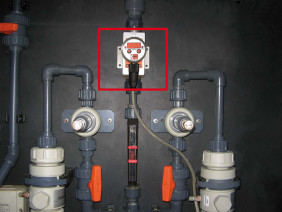Phosphate Precipitation in Waste Water Treatment Plants

Task
By addition of Iron (III) Chloride (FeCl3) in the aeration basin, the phosphates dissolved in excess waste water are chemically mixed with sludge flocculants and transferred with sludge to the sludge treatment stage. This process reduces phosphate concentration in our waterways and therefore minimises the potential for abnormal algae growth, and the detrimental effect for the aquatic eco-system.
As an overdose of Iron (III) Chloride leads to a massive pollution of water, is injurious to humans and pollutes the environment, a completely dependable method of process monitoring is paramount. A continuous fl ow measurement of the dosing chemical with a direct data connection to your process control system guarantees you maximum safety; so that possible errors are not just discovered during sample taking, when it’s too late.
Solution
With the MIK magnetic-inductive flow meter, KOBOLD Messring GmbH offers you an optimal and economical solution for safe dosage of Iron (III) Chloride. The unit was specifically developed for this application and has already proven itself very successfully in service. The device housing is made of PVDF, the electrodes in contact with the medium are made of tantalum. Both materials have proven to be totally chemically resistant.
Together with the direct mounted transmitter with stainless steel housing, this device forms a very compact yet robust unit, which is ideal for fitting inside cramped control cabinets. It allows detection of very small dosage amounts from 10 ml/min! With an analogue 4-20 mA signal (or optional pulse output) the MIK continuously communicates the measured values to your process control system, so that it allows immediate response to the latest process conditions. This increases efficiency, saving cost in the amount of Iron Chloride required to achieve phosphate removal, and protection of the environment.
Automation guarantees high standards of plant safety even at unmanned plants!





